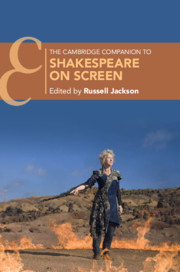124 results
289 Heart Rate Variability in Opioid Use Disordered Participants Undergoing Buprenorphine-Assisted Detoxification
- Part of
-
- Journal:
- Journal of Clinical and Translational Science / Volume 7 / Issue s1 / April 2023
- Published online by Cambridge University Press:
- 24 April 2023, p. 87
-
- Article
-
- You have access
- Open access
- Export citation
2. - Studies in Shakespeare in Performance, 2020–2021
- from The Year’s Contribution To Shakespeare Studies
-
-
- Book:
- Shakespeare Survey 75
- Published online:
- 24 August 2022
- Print publication:
- 08 September 2022, pp 375-383
-
- Chapter
- Export citation
17 - Stigma and Mental Health in the Abrahamic Religious Traditions
- from Part III - Stigma and Mental Health in Specific Contexts
-
-
- Book:
- The Cambridge Handbook of Stigma and Mental Health
- Published online:
- 28 July 2022
- Print publication:
- 11 August 2022, pp 347-366
-
- Chapter
- Export citation
Preface
-
- Book:
- The Cambridge Companion to Shakespeare on Screen
- Published online:
- 11 December 2020
- Print publication:
- 17 December 2020, pp xi-xi
-
- Chapter
- Export citation
Introduction
-
-
- Book:
- The Cambridge Companion to Shakespeare on Screen
- Published online:
- 11 December 2020
- Print publication:
- 17 December 2020, pp 1-6
-
- Chapter
- Export citation
Illustrations
-
- Book:
- The Cambridge Companion to Shakespeare on Screen
- Published online:
- 11 December 2020
- Print publication:
- 17 December 2020, pp viii-viii
-
- Chapter
- Export citation
Part III - Critical Issues
-
- Book:
- The Cambridge Companion to Shakespeare on Screen
- Published online:
- 11 December 2020
- Print publication:
- 17 December 2020, pp 147-184
-
- Chapter
- Export citation
Contributors
-
- Book:
- The Cambridge Companion to Shakespeare on Screen
- Published online:
- 11 December 2020
- Print publication:
- 17 December 2020, pp ix-x
-
- Chapter
- Export citation
Part I - Adaptation and Its Contexts
-
- Book:
- The Cambridge Companion to Shakespeare on Screen
- Published online:
- 11 December 2020
- Print publication:
- 17 December 2020, pp 7-64
-
- Chapter
- Export citation
Note on References
-
- Book:
- The Cambridge Companion to Shakespeare on Screen
- Published online:
- 11 December 2020
- Print publication:
- 17 December 2020, pp xii-xii
-
- Chapter
- Export citation
Contents
-
- Book:
- The Cambridge Companion to Shakespeare on Screen
- Published online:
- 11 December 2020
- Print publication:
- 17 December 2020, pp v-vii
-
- Chapter
- Export citation
11 - Questions of Racism: The Merchant of Venice and Othello
- from Part III - Critical Issues
-
-
- Book:
- The Cambridge Companion to Shakespeare on Screen
- Published online:
- 11 December 2020
- Print publication:
- 17 December 2020, pp 149-160
-
- Chapter
- Export citation
Part II - Genres and Plays
-
- Book:
- The Cambridge Companion to Shakespeare on Screen
- Published online:
- 11 December 2020
- Print publication:
- 17 December 2020, pp 65-146
-
- Chapter
- Export citation
Filmography
-
- Book:
- The Cambridge Companion to Shakespeare on Screen
- Published online:
- 11 December 2020
- Print publication:
- 17 December 2020, pp 264-268
-
- Chapter
- Export citation
Further Reading
-
- Book:
- The Cambridge Companion to Shakespeare on Screen
- Published online:
- 11 December 2020
- Print publication:
- 17 December 2020, pp 249-263
-
- Chapter
- Export citation
Copyright page
-
- Book:
- The Cambridge Companion to Shakespeare on Screen
- Published online:
- 11 December 2020
- Print publication:
- 17 December 2020, pp iv-iv
-
- Chapter
- Export citation
Part IV - Directors
-
- Book:
- The Cambridge Companion to Shakespeare on Screen
- Published online:
- 11 December 2020
- Print publication:
- 17 December 2020, pp 185-248
-
- Chapter
- Export citation
Index
-
- Book:
- The Cambridge Companion to Shakespeare on Screen
- Published online:
- 11 December 2020
- Print publication:
- 17 December 2020, pp 269-280
-
- Chapter
- Export citation

The Cambridge Companion to Shakespeare on Screen
-
- Published online:
- 11 December 2020
- Print publication:
- 17 December 2020
Changes in hospitalized coronavirus disease 2019 (COVID-19) patient characteristics and resource use in a system of community hospitals in the United States
- Part of
-
- Journal:
- Infection Control & Hospital Epidemiology / Volume 42 / Issue 2 / February 2021
- Published online by Cambridge University Press:
- 12 October 2020, pp. 228-229
- Print publication:
- February 2021
-
- Article
-
- You have access
- Open access
- HTML
- Export citation



